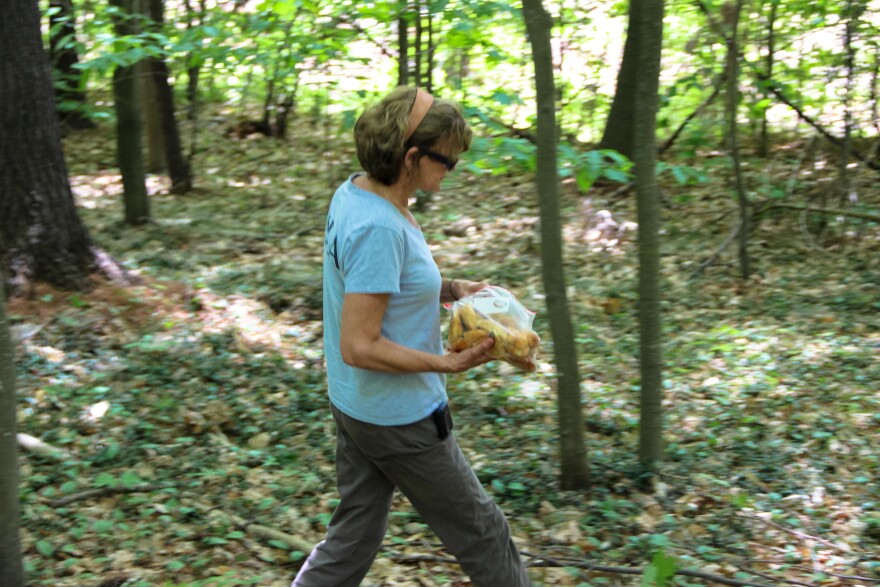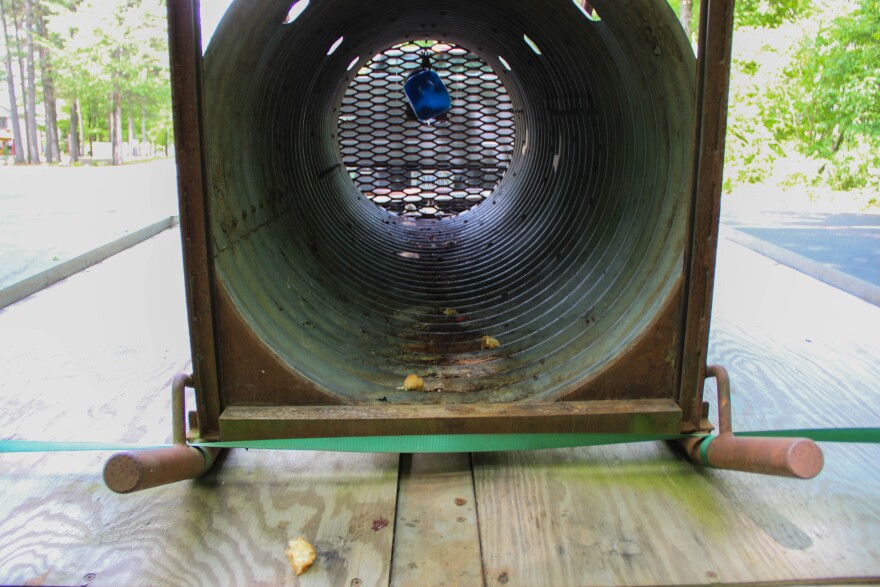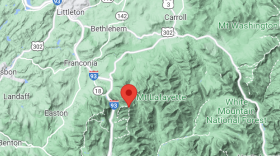Growing up in Loudon, Andrew Timmins didn’t see his first bear until he was nearly 20. Now, as Fish & Game’s Bear Project leader, Timmins manages the state’s population of more than 5,500 bears. NHPR’s Sean Hurley recently spent a day with Timmins at a bear hotspot at the Attitash Ski Resort and learned how the state regularly catches troublesome bears and relocates them to the northernmost part of the state.
In a condo complex across the road from Attitash, Andrew Timmins crouches behind a tree, watching a young bear clinging to the trunk of a tall pine. “He’s moved down lower,” Timmins whispers. “He’s on a lower branch now and acts like he’s interested in coming down.”
Five minutes earlier, Nancy Comeau, a bear technician with the USDA Wildlife Services, hung a vanilla soaked rag upwind of the bear and made a Hansel and Gretel trail of donuts through the woods and into a bear trap retrofitted from an 8 foot long steel culvert. “So we're just kind of waiting to see if he picks up the scent of the donuts or the vanilla,” Comeau says.


But the tree the bear is in stands right next to the railroad tracks and a passing train stops the bear’s downward progress. “He's out on the limb close to the trunk,” Comeau says, “but he's got all four legs just dangling off the limb and he's taking a little snooze.”
Andrew Timmins says a watched pot never boils, so we go off for a walk and he explains why bears like this need to be trapped and relocated to the wild. “If we don’t move these animals,” Timmins says, “they will become conditioned to the point where you can’t break it. And those bears don’t live long in the state.”
In North Conway just the prior week, Timmins had to perform the least pleasant part of his job. “We were forced to lethally remove two bear families,” he says ruefully. “Some of the offspring we released, others we had to dispatch because of home entry.”

While not common, bears that enter homes are often the result of well meaning, but misguided attempts by people to befriend the wild animals. “It's us as a society that make bears that way and we can do better,” Timmins says. “You know we can we can change our behavior so that bears can co-exist in our landscape without causing a lot of conflict.”
A pickup truck races toward us and one of the Attitash maintenance crew stops to let us know the bear is showing signs of coming down the tree so we turn around and head back. “At this distance,” Timmins says, “you actually might even hear the bear's claws on the tree as he comes down but you would absolutely hear that guillotine door drop on that.”

A blue bucket filled with donuts hangs on the far side of the trap. If the bear tugs it, the trap door will slam shut. Timmins finds his earlier tree and crouches down to watch. “He’s starting to come down the tree,” Timmins says, “so he’s going to find the food we left for him and hopefully find his way into the trap.”
Once down, the bear noses around the leaves until he finds something he likes. Timmins continues to give a play by play in a whisper, “He’s eating some of the donuts on the ground.”
Nancy Comeau watches from behind her pickup truck, holding her breath as the bear approaches the trap - goes in, comes out, circles - finally enters and grabs the bait bucket.

And the guillotine trap slams shut.
“That was pretty typical,” Nancy Comeau says, as we head for the trap. “They go in one time, kind of give it a little test, come back out, go back in and decide it's good and pull the bait.”

The bear scratches at the walls and pushes at the trap doors. “Now we're going to immobilize him,” Timmins says, “and put ear tags in him and get him ready to transport North.”
As Timmins gets the bears attention at one end of the trap, his Fish & Game partner Will Staats guides a jab stick inside and injects the bear with a tranquilizer.

Two minutes later, the bear is out cold. The trap is opened and Timmins pulls the young bear out. It’s a girl – about 50 pounds, he says, as he affixes the ear tags –

And the bear is set back into the trap.
“Like I said we don't enjoy moving bears,” Timmins says. “I mean it's not the answer. The answer is you know making sure there's no attractants that lure them into this lifestyle. And that's our ultimate goal.”

Timmins hooks the trailer with the trap to his pickup. He’ll drive the yearling bear beyond Lake Francis up a long logging road and set her free in the northernmost part of the state - hoping he never sees her again.









